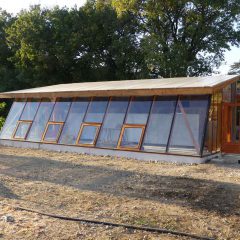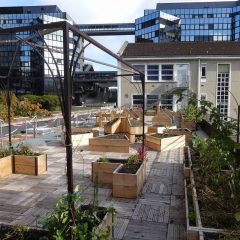A spiral of aromatics is a three-dimensional flower bed for the cultivation of aromatic herbs.
The spiral of aromatics is an example of permacultural design. Its construction makes it possible to respond, on a minimum of space, to the climatic requirements of the different plants.
The bottom of the spiral begins with a small pond on the south side. This creates a humid microclimate and reflects light and heat on the south wall behind the roots of thermophilic plants. The land is rich, mixed for example with compost.
The central part corresponds to growth conditions typical of Central Europe, without much humus and more permeable than in the wetland. Zones are in partial shade. The plants growing in this area are, for example, parsley, coriander, tarragon, caraway, oregano or basil.
The upper part of the spiral is a dry zone. The soil is permeable and rather poor, and may contain sand. The internal structure of the spiral of aromatics ensures good drainage. These are ideal conditions for many Mediterranean plants such as sage, thyme or lavender.









